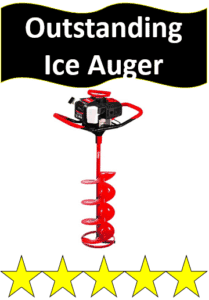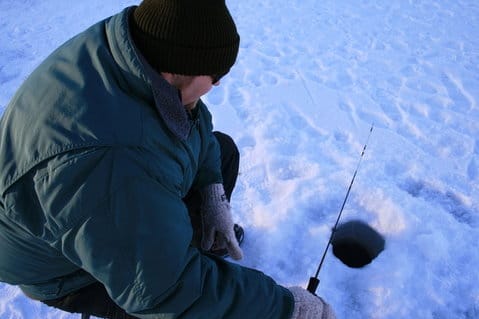
Whether you’re an old hand at ice fishing who has learned to do things the old school way or an eager relatively new winter angler looking to get into this awesome recreational activity, the question of which ice auger is best will definitely come up more than once. Some people really like the traditional way with the manual auger, others swear by the added convenience and speed that comes from a gas or electric model.
So in a head to head to head comparison – which style of ice auger is best? That is the million dollar question here, isn’t it?
Read on to see the pros and cons of each style of ice auger. Once you see what each type has to offer then you will be able to make an informed decision to figure out which on is best for you and your specific winter fishing needs!
 Electric Ice Augers
Electric Ice Augers
This one is a relatively short entry because as of right now there’s only one really high quality electric powered auger that either of us would recommend. Not sure how they keep the battery powerful and charged when it’s out in the heavy cold – but they’ve managed to do it.
One of the common selling points is the ability to power through 66 holes in one battery charge, so even in extreme cold you should have no problem making sure you get through the ice. However they’ve managed to solve the battery problem, this company has done it.
Our pros and cons are based around this top notch model, which is consistently being held up as one of the best powered ice augers out there from experienced ice fishermen.
PROS
- Don’t have to mess with fuel or changing fuels
- The model we recommend is extremely high end and advanced
- Easier to use and faster than manual model
- Generally starts easier than many gas augers
- All early feedback points to an extremely high rating from experienced ice fishing enthusiasts
- Minimizes slush/mess when drilling holes through the ice
CONS
- Still hard not to be nervous about batteries in extreme cold, although they’ve seemed to hold up so far
- Not as easy for the average handyman to fix (especially compared to familiar gas engines)
- Will be heavier than manual models (though lighter than many gas models)
- Can be a touch pricy
 Gas Ice Augers
Gas Ice Augers
Gas powered augers have been around for quite some time, and while we are currently grouping together traditional gas as well as propane fueled, it is worth understanding that there are some notable differences between the two. For the purpose of a quick answer we are grouping them together, though if you really want to delve deep it is worth noting that there are some common separations between the two.
Gas augers have plenty of advantages. They don’t have the issues with a draining charge (especially in ultra cold weather) that electric ice augers are likely to have and they also punch through the ice much quicker than any manual unit.
Whether traditional gas or propane, they tend to perform really well when a very large number of holes need to be drilled into the ice, even when the ice itself is particularly thick.
Often times the questions on whether or not a gas auger is right for you is whether you want to bother with making holes with a manual auger or if you want to save your energy for fishing by using a gas powered auger to punch through the ice.
PROS
- Best option for when you need to drill a LOT of holes in the ice
- Cuts through really thick ice easier than going the manual route
- Cuts through ice very quickly and effectively
- Less physical effort needed to cut through the ice
CONS
- Not appropriate for indoor (in shelter) use because of potentially dangerous fumes
- Can get “ornery” and be hard to keep running
- Will wear down or need repairs/maintenance given enough passing time and use
- Can be a pain to lug around if you have to make several holes quite far apart from one another
 Manual Ice Augers
Manual Ice Augers
Some guys like going the traditional route, and when it comes to enjoying the great outdoors I’m a big believer that you should always do it your way. There’s a reason I’m a particularly big fan of rustic hiking trails: moving over downed trees and scaling up hills that require small sections of rock climbing – that’s just fun! If you love the manual effort of creating your own fishing holes by hand, then a manual auger might be the way to go!
Manual augers have an obvious advantage of always working as long as you keep the blades sharp. There’s no need for fuel, no pulling to get it started, to battery to rely on. If well taken care of these can last many years or even decades.
On the other side of things, this must all be muscled power and thus will take more physical work and exertion than any other method. For some anglers this will be a positive while for others they will be eyeing the other ice fishing anglers with jealousy as they are using gas and electric powered augers to just cut on through quickly hole after hole.
Manual ice augers are pretty self explanatory and are going to be for a certain type of outdoorsman, but won’t compare to the other options for others.
Pros:
- No complex parts, so can’t break down
- Easy to keep blades sharp, can be effective for decades
- Very simple to use
- Requires most physical exertion (good if you like the minor fitness aspect)
- Inexpensive compared to the electric and gas powered ice augers
- Very lightweight compared to other options
Cons:
- Slowest of the three options
- Most physical exertion (can be a bad thing if you prefer simple and straight forward)
- Worst option for having to make a large number of holes in an area
So What’s the Verdict?
There are several different options when it comes to getting the ice auger that’s going to work best for you, but as you can see from our article and from the comparison chart, there are definitely pros and cons to each style of ice auger and understanding these lists will help you to figure out what the best match for you and your winter angling outings really is.
If you want information on our choice for the absolute best ice augers out there, click on that article for a full review of our favorite electric, gas, and manual augers for ice fishing.
Very Quick Gas Vs Manual Ice Auger Comparison

